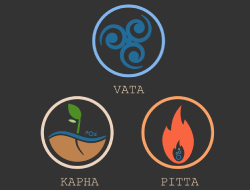Digestion
The Ayurvedic perception of digestion is summed up in the term ‘Jatharagni’. In the simplest possible sense this can be interpreted as ‘Digestive Fire’ (Jathar = the digestive tract ; Agni = fire). When it is working well it has an enzymatic type of action, whereby the processing of foods is complete and the metabolism is balanced, ensuring the efficient working of all the body systems.
However, if the agni is weak this results in the production of ama (toxic waste).
What are the symptoms of Ama?
Every organ and system has its own ‘fire’ and if it is not functioning optimally there is a resulting build-up of toxic waste which clogs the lymphatic system, the arteries and the liver. Heart disease and disorders of the central nervous system can follow. Another disorder arising from extreme accumulation of ama is arthritis, when the body’s tissues are affected. Where ama is in excess, endocrine problems, in particular hypothyroidism, are frequently found. This is a problem of low Pitta and as all mitochondrial functions are dependent on balanced Pitta there is a deficiency of body energy.
Does Ayurveda prescribe an ideal diet?
An essential difference between the Ayurvedic and the western medical approach to diet is that Ayurveda does not standardise its recommendations. On the contrary, it recognises that the Vata, Pitta and Kapha characteristics of each individual are unique, and there are even variations due to season and age.
What are some examples of Ayurvedic dietary recommendations?
Ayurveda recognises that an individual’s dietary requirements vary according to time or place, circumstances and bodily condition. It does not generally view foods as ‘good’ or ‘bad’ but rather considers the effects of specific foods, as well as the differences in the effect of combining the foods in different ways or of consuming them in a different form at different times. For example, hot water is seen to stimulate in cold weather. Warmed orange juice has a very different effect from that drunk cold. It is also recognised that for every food there is an antidote – valuable knowledge when dealing with intolerancies or even allergies.
Ama
In Ayurveda ama implies anything that is in a state of incomplete transformation. Specifically, it refers to a toxic by-product of improper or incomplete digestion.
How does ama express itself in our bodies ?
When foods are not properly digested this leads to an excess of bad bacteria, initially in the gut. Kapha aggravation leads to a build up of mucus which then hardens in many other places, notably the nose, ears and eyes, as well as causing various types of coatings of the tongue and genital discharges. A fungal condition can also affect the scalp, appearing as a type of dandruff. These conditions can occur overnight or can build up over days, weeks or months.
How does Ayurveda treat ama accumulation ?
Nasal, eye and ear drops need to be used regularly to prevent a build up, as do a tongue scraper, tooth powder and gum massage oils. Herbal medicines and certain foods, such as bitter melon, can be used to prevent the bacteria from multiplying and to complete the processing of foods, preventing an excess of Pitta.
Ayurveda also uses ‘Panchakarma’ – a comprehensive individualised detoxification program – to promote the excretion of toxic substances, such as the by-products of unprocessed protein, as if left to accumulate they will lead to inflammation. This expresses itself as systemic disease, such as asthma affecting the lungs, or arthritis in the joints. Panchakarma also utilises special massage oils to help in the detoxification process.


















